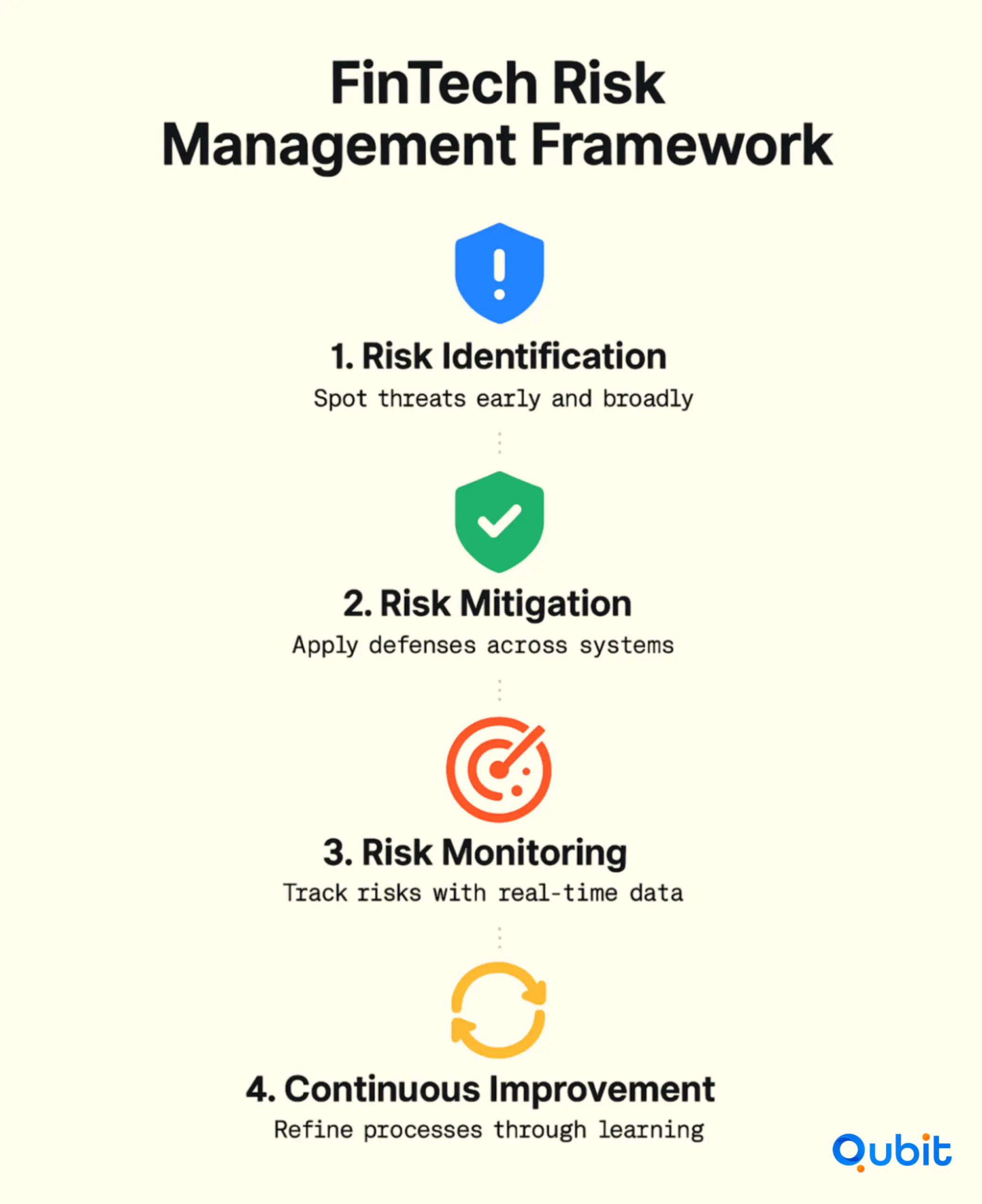Fintech startups are reshaping the financial industry, but securing funding in this competitive sector requires more than just innovative ideas. With global fintech net revenue projected to grow from $150 billion in 2023 to $400 billion by 2028, according to the Omnius Fintech Industry Report 2024, the market potential is undeniable. However, challenges such as investor caution—highlighted by a 62% drop in U.S. fintech funding year-over-year in Q2 2024—underscore the importance of robust risk management strategies.
For startups aiming to thrive, understanding the balance between opportunity and risk is crucial. A broader perspective on funding options is offered through the discussion on fintech fundraising strategies and opportunities, which illustrates trends and market nuances that complement your risk management considerations.
Navigating the Fintech Risk Landscape and Regulatory Hurdles
The fintech industry is evolving rapidly, but with growth comes a host of risks and regulatory challenges. As fintech companies push the boundaries of innovation, they must also address increasing scrutiny from regulators and the complexities of compliance.
Regulatory Challenges in Fintech
One of the most pressing issues for fintechs is the growing demand for compliance with regulatory frameworks. For instance, the FSB report on fintech-related financial stability issues highlights concerns about the potential impact of fintech innovations on global financial stability. Additionally, the OCC publication on responsible innovation in banking emphasizes the importance of aligning innovation with regulatory expectations.
The Blurring Lines Between Fintechs and Banks
The convergence of fintechs and traditional banks is reshaping the financial landscape. Fintechs are increasingly pursuing bank charters, while banks are collaborating with fintechs to enhance their digital offerings. This trend not only highlights the shifting regulatory boundaries but also underscores the need for robust compliance strategies.
For a deeper dive into how these regulatory challenges intersect with funding obstacles, explore our segment on fintech regulatory challenge.
Compliance Risks and Penalties
Non-compliance with regulations can lead to significant financial penalties. For example, violations of GDPR can result in fines of up to 4% of a company’s revenue. This underscores the critical need for fintechs to prioritize data protection and regulatory adherence.
By addressing these challenges head-on, fintech companies can not only mitigate risks but also position themselves for sustainable growth in a highly competitive market.
Proactive Strategies for Fintech Startup Risk Management
Effective risk management is the backbone of fintech success, ensuring operational stability and fostering trust among stakeholders. Fintech companies face unique challenges, from regulatory compliance to cybersecurity threats, making proactive strategies essential for mitigating risks and maintaining growth.
1. Establish Dedicated Risk Management Teams
Building specialized teams focused on risk management is a critical first step. These teams should be equipped with expertise in regulatory frameworks, financial analysis, and cybersecurity. Their role extends beyond identifying risks to actively monitoring and responding to emerging threats, ensuring the company remains agile in a dynamic environment.
2. Conduct Regular Risk Assessments
Periodic evaluations of potential risks help fintech companies stay ahead of vulnerabilities. These assessments should cover operational, financial, and technological risks, providing actionable insights to refine strategies. For example, analyzing expenditure optimization through fintech capital requirements management can align capital allocation with strategic risk assessment.
3. Implement Robust Cybersecurity Measures
Cybersecurity is non-negotiable in fintech. Deploying advanced encryption protocols, multi-factor authentication, and regular system audits can safeguard sensitive data and prevent breaches. Additionally, integrating cybersecurity measures into product development ensures security is embedded from the outset.
4. Develop Continuity and Disaster Recovery Plans
Preparation for unexpected disruptions is vital. Continuity plans should outline steps for maintaining operations during crises, while disaster recovery plans focus on restoring systems and data swiftly. These frameworks minimize downtime and protect customer trust during challenging times.
Proactive risk management strategies not only shield fintech companies from potential pitfalls but also position them as reliable and resilient players in the industry.
Structured Framework for Fintech Startup Risk Management
Effective risk management in fintech requires a systematic approach that addresses the dynamic challenges of the industry. A structured framework ensures risks are not only identified but also mitigated, monitored, and continuously improved upon.

1. Risk Identification
The first step involves pinpointing potential risks across operational, financial, regulatory, and technological domains. Fintech companies must assess vulnerabilities such as cybersecurity threats, compliance gaps, and market volatility. By conducting regular audits and utilizing advanced analytics, organizations can uncover hidden risks that may impact their operations.
2. Risk Mitigation
Once risks are identified, implementing strategies to reduce their impact becomes crucial. This includes deploying robust cybersecurity measures, adhering to regulatory standards, and diversifying financial portfolios. Collaboration across departments ensures that mitigation plans are comprehensive and address risks from multiple angles.
3. Risk Monitoring
Continuous monitoring is essential to stay ahead of emerging threats. Fintech firms can leverage real-time data and predictive analytics to track risk indicators. Regular reporting and dashboards provide actionable insights, enabling swift responses to any deviations from expected outcomes.
4. Continuous Improvement
Risk management is not a one-time activity; it requires ongoing refinement. By integrating feedback loops and learning from past incidents, fintech companies can enhance their frameworks. This iterative process ensures adaptability to evolving risks and fosters sustainable growth.
Practical Risk Assessment Models and Guidance for Fintech Startup
Effective risk assessment is crucial for fintech startups aiming to navigate the complexities of financial technology. By employing structured models and calculations, fintech enterprises can identify, analyze, and mitigate risks effectively.
Qualitative Risk Analysis: Simplifying Risk Factors
Qualitative risk analysis provides a foundational approach to understanding potential vulnerabilities. For instance, a Qualitative risk factor (RF) can be calculated using a simplified formula:
RF = 75% × 0.3 = 22.5%
This calculation highlights how qualitative metrics can quantify risk probabilities and impacts, offering fintech startups a clearer perspective on their exposure.
Quantitative Risk Analysis: Financial Implications
Quantitative methods, such as the Expected Monetary Value (EMV) calculation, delve deeper into the financial consequences of risks. For example:
EMV = 80% × US$1,200,000 = US$960,000
This approach enables fintechs to assess the monetary impact of specific risk scenarios, helping them prioritize mitigation strategies based on financial significance.
Applying the Fintech Risk Assessment Model
The Fintech Risk Assessment Model is a comprehensive tool designed for startups. It integrates risk identification, qualitative analysis, and quantitative evaluations to create a holistic risk management framework. Early-stage fintechs can use this model to systematically categorize risks, analyze their potential impacts, and develop actionable strategies to address them.
By combining qualitative and quantitative methods, fintech startups can build robust risk management systems that align with their operational goals and financial realities.
Conclusion
Fintech startups face unique challenges in risk management and securing funding, but a structured approach can make all the difference. By implementing a robust framework, embracing technological advancements, and conducting proactive risk assessments, businesses can safeguard their operations while positioning themselves for growth. These strategies not only mitigate potential pitfalls but also enhance investor confidence, paving the way for sustainable success.
We at Qubit Capital specialize in connecting startups with potential investors while ensuring effective risk management. Explore our Investor Outreach service to take the next step in scaling your fintech venture.
Key Takeaways
- Risk management is critical for fintech startups seeking funding.
- A structured framework combining risk identification, mitigation, and continuous improvement drives sustainable growth.
- Advanced technologies like AI and blockchain enhance predictive risk assessment.
- Regulatory compliance and proactive measures build investor confidence.
- Actionable strategies empower fintech startups to navigate complex risk landscapes.
Frequently asked Questions
What is risk management in fintech?
Risk management in fintech refers to the process of identifying, evaluating, and addressing risks that could impact regulatory compliance, operational efficiency, or cybersecurity. This ensures investor confidence and supports sustainable business growth.


 Back
Back



